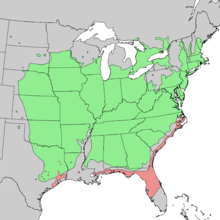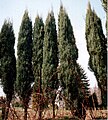Virginian juniper
| Virginian juniper | ||||||||||||
|---|---|---|---|---|---|---|---|---|---|---|---|---|

Virginian juniper ( Juniperus virginiana ), habit and habitat |
||||||||||||
| Systematics | ||||||||||||
|
||||||||||||
| Scientific name | ||||||||||||
| Juniperus virginiana | ||||||||||||
| L. |
The Virginian juniper ( Juniperus virginiana ), also called pencil cedar , Virginian cedar or Virginian red cedar , is the largest species of the genus juniper ( Juniperus ). It is native to North America. In 1664 it was introduced to Europe, where it is completely hardy. In central European gardens the narrow, blue-green column shape 'Skyrocket' is often planted. All parts of the Virginian juniper are highly poisonous.
description
Vegetative characteristics
The slow-growing Virginian juniper reaches heights of 15 to 25 meters, but under optimal conditions also up to 40 meters with a trunk diameter of up to 1 meter. The maximum age is given as up to 300 years. The Virginian juniper forms a taproot . The bark is brown in color.
Both 3 to 9 millimeters long needle-shaped leaves and 1 to 5 millimeters long, scale-shaped leaves (they overlap over at least a quarter of their length) are formed. The leaves have an aromatic smell when rubbed and have a lifespan of one to three years.
Generative characteristics
The Virginian juniper is mostly monoecious ( monoecious ), in individual cases also dioecious ( dioecious ) separate sexes. It blooms from March to May. The stalked, spherical to egg-shaped, when ripe blue-frosted to brownish-blue cones are 3 to 7 millimeters in size and contain one to three seeds. The cones ripen in the first year from September to November. The seeds are 1.5 to 4 millimeters in size.
The number of chromosomes is 2n = 22.
Occurrence
The distribution area of the Virginian juniper lies with 2 varieties in the eastern half of North America from the Canadian provinces of Québec and Ontario to the states of North Florida and Texas in the southern United States. In the states of Colorado and Oregon , this juniper has spread from plantations.
The Virginian juniper grows on shallow, nutrient-poor rock soils or on wet to swampy, deep soils. It partly forms pure stands, but mostly it occurs in mixed forests with pine and oak species. The variety Juniperus virginiana L. var. Silicicola can be found on coastal dunes and coastal river sand banks at low altitudes up to a maximum of 15 meters above sea level.
In the United States' Great Plains , this juniper can be weed- like as an invasive species .
Toxicity
All parts are very poisonous. The needles of the Virginian juniper contain about 0.2% essential oil with the main components sabinene , alpha-pinene , gamma-terpinene and limonene . The ingredients are suspected to be carcinogenic. After Sabinen contact, there was a significant increase in the incidence of spontaneous tumors through the use of wood chips as litter in cages with sensitive mouse strains.
In the case of poisoning, cramps, shortness of breath and collapse appear; in severe cases death follows in unconsciousness. On the other hand, the berry-shaped cones are used to make gin . According to North Carolina State University's Consumer Horticulture website, Juniperus virginiana is only slightly poisonous when ingested.
use
The Virginian juniper is a heartwood tree with a red-brown, fragrant core. The wood is durable, easy to work and carve. It is used to make pencils . It is also used as a block for the recorder in instrument making .
Systematics
The first publication of Juniperus virginiana was done by Carl von Linné .
Of Juniperus virginiana , there are two varieties:
- Juniperus virginiana L. var. Virginiana : It occurs in the Canadian provinces of Ontario and Québec . It settles in the US states of North Dakota , South Dakota , Nebraska , Kansas , Oklahoma and Texas as well as all other states located eastward.
- Juniperus virginiana var. Silicicola (Small) AEMurray ( Syn . : Juniperus silicicola (Small) LHBailey ) on the coasts of the US states lying east on the Atlantic Ocean , starting north with North Carolina , continuing south with South Carolina , Georgia and northern Florida ; now westward along the coasts of the Gulf of Mexico with Alabama , Mississippi , Louisiana and Texas.
Danger
The Virginian juniper in its entirety is included in the Red List of Threatened Species by the International Union for Conservation of Nature ( IUCN ), but is designated as “Least Concern”. The population is increasing and spreading, among other things, on fallow fields and along roadsides.
photos
swell
literature
- Robert P. Adams: Juniperus of Canada and United States: Taxonomy, Key and Distribution . In: Phytologia . tape 90 , no. 3 , 2008, p. 255-314 ( juniperus.org [PDF; 4.6 MB ]).
- Robert P. Adams: Juniperus virginiana in Flora of North America , Volume 2, 1993. (English)
- Lutz Roth, Max Daunderer , Kurt Kormann: Poison Plants - Plant Poisons. Occurrence, effect, therapy, allergic and phototoxic reactions. With a special section about poisonous animals. 6th, revised edition, special edition. Nikol, Hamburg 2012, ISBN 978-3-86820-009-6 .
Individual evidence
- ^ Virginian juniper at Tropicos.org. In: IPCN Chromosome Reports . Missouri Botanical Garden, St. Louis
- ^ Stubbendieck, J., GY Friisoe, & MR Bolick: Weeds of Nebraska and the Great Plains. In: USDA / NRCS - Invasive and Noxious Weeds. Nebraska Department of Agriculture, Bureau of Plant Industry, Lincoln, Nebraska., Accessed June 16, 2010 .
- ^ Angier, B .: "Field Guide to Edible Wild Plants" . Stackpole Books, Harrisburg 1974, pp. 255 pp .
- ^ Germplasm Resources Information Network (GRIN): Taxon: Juniperus virginiana L. var. Virginiana. In: GRIN Taxonomy for Plants. United States Department of Agriculture Agricultural Research Service, accessed June 15, 2010 .
- ^ Robert P. Adams: Geographic Variation in Juniperus silicicola and J. virginiana of the Southeastern United States: Multivariate Analyzes of Morphology and Terpenoids . In: Taxon . tape 35 , no. 1 , 1986, pp. 61–75 ( juniperus.org [PDF; 4 kB ] Variety determination of J. silicicola to J. virginiana var. silicicola).
- ^ Germplasm Resources Information Network (GRIN): Taxon: Juniperus virginiana L. var. Silicicola (Small) AE Murray. In: GRIN Taxonomy for Plants. United States Department of Agriculture Agricultural Research Service, accessed June 15, 2010 .
- ↑ Juniperus virginiana in the endangered Red List species the IUCN 2013. Posted by: A. Farjon, 2011. Accessed July 17, 2020th
Web links
- Thomas Meyer: Data sheet with identification key and photos at Flora-de: Flora von Deutschland (old name of the website: Flowers in Swabia ).
- RPAdams: The Juniperus of the World / Taxa of Juniperus. Retrieved June 16, 2010 .
- Information on the species Juniperus virginiana . In: The Gymnosperm Database. January 14, 2011, accessed January 26, 2011 .
- Plants Database: Plants Profile: Juniperus virginiana. In: NRCS Natural Resources Concervation Service. USDA United States Department of Agriculture, accessed June 16, 2010 .
- Germplasm Resources Information Network (GRIN): Taxon: Juniperus virginiana L. In: GRIN Taxonomy for Plants. United States Department of Agriculture Agricultural Research Service, accessed June 15, 2010 .
- Juniperus virginiana in the endangered Red List species the IUCN 2013. Retrieved on 17 July 2020th
- Ralf Rebmann: Poisonous Plants - Juniperus_virginiana. In: website. October 31, 2007, accessed June 16, 2010 .







